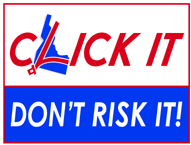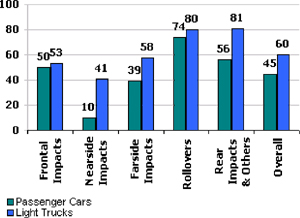
|
CONNECTIONS
|
IDAHO
ITD
HOME
IDAHO DMV
ITD NEWS
HIGHWAY
SAFETY
IDAHO STATE
POLICE
TRAVEL SERVICES
STATE OF IDAHO
NATIONAL
AASHTO
AAMVA
AAA of IDAHO
FEDERAL HIGHWAYS
FEDERAL AVIATION
IDAHO STATE POLICE
NHTSA
NTSB
TRB
U.S. DOT
Idaho
Transportation
Department
Public Affairs Office
P.O. Box 7129
Boise, ID 83707
208.334.8005
Fax: 208.334.8563
Email

More
Idahoans choose to drive while buckled
Seat belt usage up, injuries fatalities down, in 2004
The numbers are in, and they show that more Idahoans are buckling up! According to Mary Hunter, adult occupant protection specialist with the Office of Traffic and Highway Safety, the number of people using safety restraints in traffic crashes reached an all-time high of 74 percent in 2004.
 The
result was fewer deaths and serious injuries, despite an increase in
traffic crashes.
The
result was fewer deaths and serious injuries, despite an increase in
traffic crashes.
Hunter said that traffic crashes increased to 28,332 in 2004, up from 25,076 in 1999; at the same time, the number of people killed dropped to 196, down from 237 respectively.
The number of unrestrained people who were seriously injured or killed went down as well. Hunter attributes it to increased seat belt use.
According to Automotive Coalition for Traffic Safety, Inc. (http://www.actsinc.org/safetybelts.cfm) safety belts are the single-most effective occupant protection device available for adults in motor vehicles today. According to the National Highway Traffic Safety Administration, here is how effective safety belts are in reducing your chances of being killed in a crash:
 Idaho
law requires all vehicle occupants to wear safety restraints, regardless
of where they are seated. Increased enforcement of the law likely has
contributed to an increase in seat belt usage.
Idaho
law requires all vehicle occupants to wear safety restraints, regardless
of where they are seated. Increased enforcement of the law likely has
contributed to an increase in seat belt usage.
Idaho’s “Click It, Don’t Risk It!” campaign has effectively explained the importance of buckling up and warned that officers are committed to enforcing the law.
The campaign parallels an aggressive national seat belt education campaign. Idaho received $3.4 million in federal grant funds the past six years for its seat belt efforts following a competitive application process and an incentive funding process that allocates funds to states that increase seat belt use.
Following the launch of the “Click It, Don’t Risk It!” campaign, ITD conducted a series of telephone surveys with Idaho residents, and learned that the educational components were successful in creating meaningful changes in knowledge and attitudes.
Hunter said most survey respondents indicated a desire to stay safe as a motivating factor for buckling up. But, Hunter said it was noteworthy that a desire to set a good example was named almost as frequently.
“It certainly suggests that the family values messaging was well-received by the public and was an effective tool in Idaho,” she said.
Idaho’s seat belt use rate still lags behind the national rate of 80 percent. According to Hunter, $10 is the lowest fine in the country for failure to wear a seat belt. Idaho is among the states imposing a fine of just $10. Idaho’s law also does not allow officers to stop a vehicle without first noting another traffic violation. Failure to wear a seat belt cannot be the reason for a traffic stop.
Still, the educational and enforcement efforts are making a big difference, Hunter said.
“The seat belt is a free piece of safety equipment. Buckling up remains the single-best defense against serious injury or death for vehicle occupants if they are involved in a crash.”